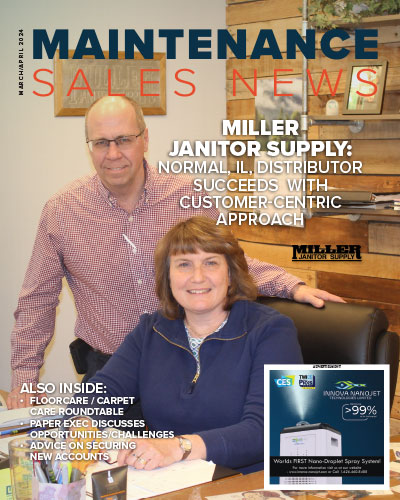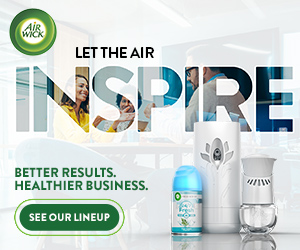Floor Disinfection Vs. Touch Point Disinfection: Understanding The Threat Of ‘Fomite Events’
By Mark Warner, National Sales Manager for The Bullen Companies
In the age of pandemics and increased awareness of hygiene, disinfection has become a crucial aspect of maintaining clean and safe environments. Disinfection processes are designed to eliminate or significantly reduce the presence of harmful microorganisms, such as bacteria, viruses, and fungi, on surfaces that readily collect them (reservoirs of pathogens). Two reservoirs of pathogens are floors and touch points. While disinfecting both are important in preventing the spread of infections, they target vastly different surfaces and require distinctly different approaches.
In addition, there is a third surface that can often be overlooked… that is “above the floor horizontal surfaces” such as countertops, desk tops, reception desks, etc. Objects that have come in contact with floors or common touch points can easily transmit pathogens to these above-the-floor surfaces by our hands or other “vehicles,” making them a threat as well. This is called a “Fomite Event.”
So, one of the biggest concerns these days is fomite events. Fomite events are when one surface contaminates another surface by using a secondary vehicle. Objects placed on floors can subsequently be placed in areas that are highly susceptible to being touched. This allows pathogens to contaminate our hands and everything our hands touch, including our eyes, nose or mouth (portals of entry). Bags, backpacks, pencils and pens are all known to come in contact with floors. They are very easily transported to surfaces that we touch, like desk tops and countertops. In fact, think about power cords, shoe laces and other dropped objects. Our bare hands certainly contact them…. often.
Touch Surface Disinfection: Definition And Importance
Touch surface disinfection focuses on the cleaning and disinfection of frequently touched surfaces, such as door handles, light switches, doorknobs, and handrails. These surfaces are hotspots for the transmission of pathogens, as they are often touched by multiple individuals throughout the day. As a result, touch point disinfection is a crucial component of infection control and is especially important in environments with a high risk of pathogen transmission, such as hospitals, public transportation, and schools.
Touch point disinfection is important for several reasons:
- Pathogen transmission: Frequent hand contact with touch surfaces can easily transfer pathogens from one person to another, increasing the risk of infection.
- Cross-contamination: Touch surfaces can become contaminated by hands or objects, which may then spread pathogens to other surfaces or individuals.
- Public health: Proper touch surface disinfection is essential for maintaining public health and preventing the spread of infectious diseases.
Floor Disinfection: Definition And Importance
Floor disinfection refers to the process of cleaning and disinfecting the floors in a particular space. Floors can harbor various microorganisms, which can be easily transferred to individuals through shoes, bare feet, or dropped objects. In fact, floors are often referred to as the “superhighways for pathogens” because microorganisms can also contaminate the wheels of carts and cleaning equipment, which are then transported all over a facility.
There are several factors that make floor disinfection important:
- Pathogen transmission: Pathogens can be transmitted via these “superhighways” throughout a facility, and may be spread from one area to another.
- Surface contamination and “Fomite Events”: Fomite events are when one surface contaminates another surface by using a secondary vehicle. Objects placed on floors can be placed in areas that are highly susceptible to being touched, which allows pathogens to contaminate our hands and everything our hands touch. This is how contaminated floors can lead to the spread of infections and sickness.
- Aesthetic appeal: Clean and well-maintained floors contribute to a pleasant and professional environment. Floors are one of the top influencers of a person’s perception of the cleanliness (and safety) of a facility. That can affect stores and businesses, as well as decisions revolving around university choices for students and their parents.
- Floor Preservation: Proper care of floors is also documented as having a very positive return-on-investment by extending the useful life span of the floors themselves.
Frequency Of Cleaning And Disinfecting:
Extreme cleanliness, disinfection and sanitary environments are most highly influenced by task frequency assignments. Task frequencies are dictated by many variables, including foot traffic volume, seasonal conditions, and infectious disease threat levels.
- Touch surfaces typically require more frequent disinfection due to their higher frequency of touch. Touch surface disinfection typically involves the use of wipes or cloths saturated with disinfectant, or the application of disinfectant sprays.
- Above-the-Floor horizontal surface disinfection frequencies are typically less frequent than touch points, using many of the same tools and material as touch point disinfection.
- In contrast, floor disinfection may be performed even less frequently, depending on the specific environment and level of foot traffic. Floor disinfection usually involves the use of specialized cleaning equipment, such as mops or floor scrubbers, and may require the application of specific disinfectant solutions.
Conclusion
In this day and age of increased awareness of infectious diseases, nothing is more crucial than maintaining clean, safe and healthy environments. Our focus needs to be on the three primary reservoirs of pathogens, paying attention to fluctuation requirements related to task frequencies. It’s all about preventing sickness and saving lives, and is there anything more important than that?
Mark Warner is the national sales manager for The Bullen Companies, and is an active member of the IICRC S400 Cleaning Standard committee and the S410 Infection Control standard committee. Previously, Warner held the position of CMI Education Manager for the ISSA. He can be reached at markw@bullenonline.com.
The Bullen Companies is a manufacturer and industry leader in the floor care, carpet care, and odor control market and has been serving the Janitorial Supply Industry with pride since 1939. Its line of branded products include: Airx, Truekleen, Clausen, e-clean, SanoVerde, Road Off and One Up along with hundreds of private label programs worldwide. To learn more about The Bullen Companies or to receive product specification literature, please email sales@bullenonline.com or visit www.bullenonline.com.





